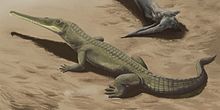| Crurotarsans | |
|---|---|

| |
| Life restoration of Protome batalaria, a phytosaur | |

| |
| Life restoration of Ornithosuchus woodwardi, a pseudosuchian archosaur | |
| Scientific classification | |
| Domain: | Eukaryota |
| Kingdom: | Animalia |
| Phylum: | Chordata |
| Class: | Reptilia |
| Clade: | Archosauromorpha |
| Clade: | Archosauriformes |
| Clade: | Eucrocopoda |
| Clade: | Crurotarsi Sereno & Arcucci, 1990 |
| Subgroups | |
Crurotarsi is a clade of archosauriform reptiles that includes crocodilians and stem-crocodilians and possibly bird-line archosaurs too if the extinct, crocodile-like phytosaurs are more distantly related to crocodiles than traditionally thought.[1] Prior to 2011, the group had invariably included only archosaurs closer to crocodilians than to birds and other dinosaurs. An equivalent term for the crocodilian side of the archosaur family tree is Pseudosuchia. This traditional definition of Crurotarsi assumed that phytosaurs were crown-group archosaurs and more closely related to crocodilians than to birds. However, a 2011 study argued that the phytosaur lineage evolved prior to the split between birds and crocodilians. This would mean that phytosaurs were not true archosaurs, and therefore could not be considered representatives of croc-line archosaurs.[1]
The name Crurotarsi is derived from the Latin word crus (lower leg) and the Greek word tarsos (ankle). It refers to the specialized articulation (a crurotarsal joint) between the lower leg (specifically the fibula) and the ankle (specifically the calcaneum) which is present in the skeletons of reptiles such as suchians and phytosaurs. In their ankle joint, a hemicylindrical condyle on the calcaneum articulates into a concave area on the fibula.[2][3]
- ^ a b Cite error: The named reference
NSJ11was invoked but never defined (see the help page). - ^ Cite error: The named reference
sereno1990was invoked but never defined (see the help page). - ^ Sereno, Paul (1991). "Basal archosaurs: phylogenetic relationships and functional implications". Journal of Vertebrate Paleontology. 11 (Suppl. 4): 1–51. doi:10.1080/02724634.1991.10011426.